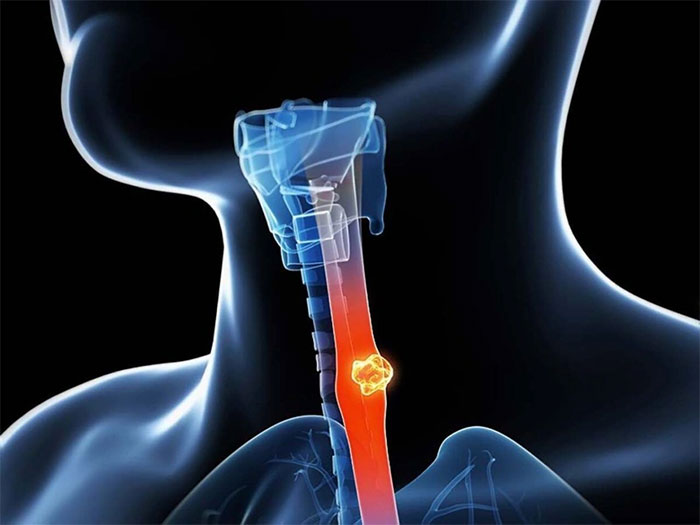Cancer screening is a crucial factor in preventing and early detecting this disease, especially for individuals with a history of chronic esophagitis, older age, obesity, and smoking.
Risk Factors for Esophageal Cancer
Esophageal cancer is quite common in both men and women, often developing silently with few clear symptoms, making it easy to confuse with other common ailments.
Esophageal cancer can be completely cured if detected early and treated promptly. However, it is rarely cured because people often seek medical attention at advanced stages.
People should undergo early screening to detect cancer, which can be completely treatable, helping you live longer and healthier.
Age
The risk of esophageal cancer is directly influenced by age and tends to increase with it. Older individuals are at a higher risk of developing esophageal cancer compared to younger people. According to various surveys, about 85% of esophageal cancer cases occur in individuals over 55 years old, particularly between the ages of 55 and 85.
Gender
Many medical surveys indicate that men have a higher risk of developing esophageal cancer than women. This is often attributed to unhealthy habits such as the use of stimulants, particularly alcohol and tobacco.
Tobacco and Alcohol
The use of tobacco products (including cigarettes, cigars, pipe tobacco, and chewing tobacco) is a major risk factor for esophageal cancer. The more one uses tobacco and the longer the duration, the higher the risk of cancer. A person who smokes a pack of cigarettes a day or more has double the risk of developing esophageal cancer compared to non-smokers. This risk does not diminish or disappear if the person quits smoking.
Alcohol consumption also increases the risk of esophageal cancer. The more alcohol one consumes, the higher the likelihood of developing esophageal cancer. Alcohol raises the risk of squamous cell carcinoma.
Smoking combined with alcohol consumption significantly increases the risk of squamous cell carcinoma more than using either tobacco or alcohol alone. These are two primary risk factors for this malignant disease.

The use of tobacco products is a major risk factor for esophageal cancer. (Image: Medscape).
Gastroesophageal Reflux Disease (GERD)
The stomach typically produces acid and enzymes to aid in digestion. In some individuals, acid can reflux from the stomach into the lower esophagus. For many, reflux causes symptoms such as heartburn or a feeling of pain in the middle of the chest.
However, in some cases, reflux may not cause any symptoms. Individuals with this condition have a higher risk of developing esophageal adenocarcinoma compared to the general population. This risk is even higher for those who experience symptoms more frequently. GERD can also lead to Barrett’s esophagus, a gastrointestinal condition associated with a higher risk of esophageal adenocarcinoma.
Barrett’s Esophagus
If acid reflux occurs into the lower esophagus for an extended period, it can damage the lining of this organ. This leads to the replacement of squamous cells with glandular epithelial cells. These glandular cells often resemble those of the stomach and small intestine. This condition is known as Barrett’s esophagus.
The longer an individual has reflux, the more likely they are to develop Barrett’s esophagus. Most people with Barrett’s esophagus experience symptoms of heartburn. However, many cases have no symptoms at all. Individuals with Barrett’s esophagus are at risk of developing esophageal adenocarcinoma.
The glandular cells in Barrett’s esophagus can become increasingly abnormal over time. This leads to dysplasia, a precancerous condition. Dysplasia is classified under a microscope. Low-grade dysplasia appears similar to normal cells, while high-grade dysplasia appears more abnormal and is associated with the highest cancer risk.
Obesity
Individuals who are overweight or obese have a higher risk of developing esophageal adenocarcinoma. This is partly explained by the fact that obese individuals are more likely to experience gastroesophageal reflux.
Diet
Some dietary components can increase the risk of esophageal cancer (such as a diet high in processed meats). This may help explain the high incidence of this cancer in certain parts of the world.

Some dietary components can increase the risk of esophageal cancer. (Image: Freepik).
On the other hand, a diet rich in fruits and vegetables is associated with a reduced risk of cancer. The exact reason for this is not clearly explained, but fruits and vegetables contain various vitamins and minerals that help prevent cancer.
Regularly consuming very hot liquids (at temperatures of 149 degrees F or 65 degrees C) may increase the risk of squamous cell carcinoma of the esophagus. The cancer risk in this case may result from hot liquids damaging the epithelial cells of the esophagus over a prolonged period.
Physical Activity
Individuals who engage in regular physical activity have a lower risk of developing esophageal adenocarcinoma. The more active a person is, the lower their risk.
Achalasia
In this condition, the sphincter of the esophagus does not relax properly, making it difficult for food and liquids to enter the stomach. They tend to accumulate in the lower esophagus, causing it to dilate over time. The cells lining the esophagus in that area may become irritated due to prolonged contact with food.
Individuals with achalasia have a significantly higher risk of developing esophageal cancer compared to those without this condition. On average, cancers are detected about 15 to 20 years after a person develops achalasia.
Tylosis
This is a rare and hereditary condition that causes additional growth of the outer skin layer on the palms of the hands and soles of the feet. Individuals with this condition also develop small tumors (papillomas) in the esophagus and have a very high risk of squamous cell carcinoma of the esophagus.
Individuals with tylosis need close monitoring to detect esophageal cancer early.
Plummer-Vinson Syndrome
Individuals with this rare syndrome have webs in the upper part of the esophagus. Typical symptoms include anemia (low red blood cell count) due to low iron levels, glossitis, brittle nails, and sometimes splenomegaly.
Most esophageal webs do not cause any problems. However, larger webs can cause food to become lodged in the esophagus, leading to swallowing difficulties and chronic irritation in that area due to food being stuck. About one in ten individuals with this syndrome will develop squamous cell carcinoma of the esophagus or hypopharyngeal cancer.
Esophageal Injury
Lye is a chemical found in strong industrial and household cleaners, such as drain cleaners. Lye is a corrosive agent that can burn and destroy cells. Ingesting a cleaning solution containing this can cause severe chemical burns in the esophagus. When the wounds heal, scar tissue may cause a part of the esophagus to become very narrow. Individuals with these injuries have an increased risk of squamous cell carcinoma of the esophagus, often occurring many years later.
History of Other Cancers
Individuals who have had certain other cancers, such as lung, oral, and pharyngeal cancers, have a higher risk of developing squamous cell carcinoma of the esophagus (about 15%). This may be due to these cancers sharing similar risk factors such as smoking and alcohol consumption.
Human Papillomavirus (HPV)
HPV is a group of over 100 types of viruses. They are known as papillomaviruses because some of them cause a type of growth called a papilloma (or wart). Individuals infected with certain types of HPV are associated with various cancers, including oropharyngeal, anal, and cervical cancers.
Signs of HPV infection have been found in 1/3 of esophageal cancer cases among patients from Asia and South Africa. However, signs of HPV infection are not present in esophageal cancer cases in other regions, including the United States. HPV is a rare cause of esophageal cancer.

















































